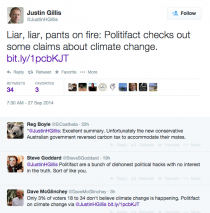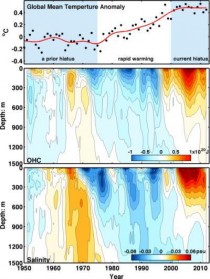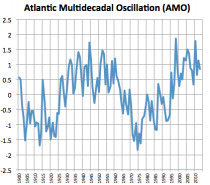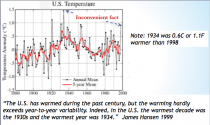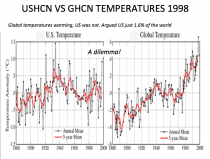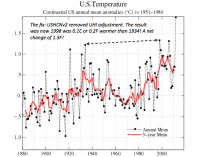Written by Camilla Turner, telegraph.co.uk
Living close to close to wind farms may lead to severe hearing damage or even deafness, according to new research which warns of the possible danger posed by low frequency noise. windfarm sunset
The physical composition of inner ear was “drastically” altered following exposure to low frequency noise, like that emitted by wind turbines, a study has found.
The research will delight critics of wind farms, who have long complained of their detrimental effects on the health of those who live nearby.
Published today by the Royal Society in their new journal Open Science, the research was carried out by a team of scientists from the University of Munich.
It relies on a study of 21 healthy men and women aged between 18 and 28 years. After being exposed to low frequency sound, scientists detected changes in the type of sound being emitted from the inner ear of 17 out of the 21 participants.
The changes were detected in a part of the ear called the cochlear, a spiral shaped cavity which essential for hearing and balance.
“We explored a very curious phenomenon of the human ear: the faint sounds which a healthy human ear constantly emits,” said Dr Marcus Drexl, one of the authors of the report.
“These are like a very faint constant whistling that comes out of your ear as a by-product of the hearing process. We used these as an indication of how processes in the inner ear change.”
Dr Drexl and his team measured these naturally emitted sounds before and after exposure to 90 seconds of low frequency sound.
“Usually the sound emitted from the ear stays at the same frequency,” he said. “But the interesting thing was that after exposure, these sounds changed very drastically.”
“They started to oscillate slowly over a couple of minutes. This can be interpreted as a change of the mechanisms in the inner ear, produced by the low frequency sounds. This could be a first indication that damage might be done to the inner ear.”
“We don’t know what happens if you are exposed for longer periods of time, [for example] if you live next to a wind turbine and listen to these sounds for months of years.”
Wind turbines emit a spectrum of frequencies of noise, which include the low frequency that was used in the research, Dr Drexl explained.
He said the study “might help to explain some of the symptoms that people who live near wind turbines report, such as sleep disturbance, hearing problems and high blood pressure”.
Dr Drexl explained how the low frequency noise is not perceived as being “intense or disturbing” simply because most of the time humans cannot hear it.
“The lower the frequency the you less you can hear it, and if it is very low you can’t hear it at all.

“People think if you can’t hear it then it is not a problem. But it is entering your inner ear even though it is not entering your consciousness.”
Earlier this week it was reported that bats were being lured to their deaths at wind farms because they think turbines are trees in which they can find shelter, food and sex.
By Joseph D’Aleo, CCM
Gillis points to Politifacts story as “justinification’ of his blind allegiance to all aspects of AGW. Steve Goddard in his comment has it right. The last comment actually is interesting claiming only 3% of the public doesn’t believe the climate is changing. Actually, there is not a skeptic I know that does not believe climate is changing, always has, always will.
In the Tampa Bay Times, Politfacts tackles 10 questions in a very weak analysis. I give them an F for effort and accuracy.
I will only touch on two items. These are their claims:
5. Surface temperatures on Earth “have stabilized.” -Mostly False.
Sen. Marco Rubio, R-Fla., has repeatedly questioned the need for proposals that address climate change, but he often tries to do it without sounding anti-science.
In an interview on Fox News in May, Rubio said he never denied that the climate was changing, but he also said that “the left loves to go around saying there is a consensus” when there is no consensus on the sensitivity of the climate, “which is why, despite 17 years of dramatic increases in carbon production by humans, surface temperatures (on) the earth have stabilized.”
Rubio has a point that over roughly the past 15 years, global surface temperatures have plateaued, particularly compared to their rapid rise in previous decades. But scientists we interviewed said the evidence suggests that the pause is temporary, with temperatures poised to rise once the oceans start releasing more heat. We rated Rubio’s claim Mostly False.
REPLY
Yes that was one of 52 excuses for the pause but where is the proof the oceans are hiding the heat? From the University of Washington and the department of Trenberth’s missing heat comes a claim that we’ll have to wait another 15 years for global warming to resume. Sounds like a goalpost mover to me.
The Oceans that Slowed 21st Century Global Warming
Why did the rapid global warming that characterized the latter part of the 20th century slow down over the last 15 years or so? Many different theories have been proposed, but a new study suggests that a massive movement of heat from shallow surface waters to deep regions of the Atlantic and Southern Oceans - but not the Pacific Ocean, as many researchers had predicted - might be responsible. Xianyao Chen and Ka-Kit Tung analyzed data from profiling floats, or oceanographic sensors that can move vertically throughout the water column, and traced the pathways that heat has taken through the world’s oceans since the turn of the 21st century. The oceans are capable of storing about 90% of the world’s surface heat content, and the researchers suggest that most of the excess heat that would have otherwise continued to fuel global warming is currently stored in the basins of the Atlantic and Southern Oceans.
Atlantic Ocean heat Content.
The Atlantic is in its warm phase of the 60-70 year AMO. It explains the increased heat since 1995. When it reenters the cold mode it will accelerate the cooling.
6. “NASA scientists fudged the numbers to make 1998 the hottest year to overstate the extent of global warming.” - Pants on Fire.
Fox News host Steve Doocy repeated something that’s been all over the Internet: the claim that scientists have fixed numbers to make 1998 the hottest year.
PunditFact found that scientists have adjusted historical data to account for weather stations that have moved or when temperatures were recorded at different times of day. That’s hardly the same thing as fudging the numbers in pursuit of a political agenda. We rated Doocy’s statement Pants on Fire.
REPLY: Doocy’s got it right. Politifacts response if more like Liberal Hair on Fire.
In 1999, NOAA and NASA reported 1998 was 1.1F cooler than 1934. Hansen admitted the 1930s was the warmest decade and 1934 the warmest year. See his quote in the image.
This US data set, though initially widely regarded as the world’s best because it was stable and had adjustments for urbanization contamination. But it was at odds with the global data set which did not have the same stability or adjustments.
In 2008 under pressure, NOAA redid the data set, removing the urban adjustment.
The result is that a 1998 that was 1.1F cooler than 1934 in 1998 became 0.2F warmer, a 1.3F change. I would regard that as fudging the data in pursuit of a political agenda so Doocy was right on.
Brought Down By Good Intentions
I’ve warned you many times that our power grid is unstable. The infrastructure is old. The security protecting the grid is porous. The amount of power it is able to supply is just barely outstrips the demands we place on it.
And demand is growing, while supply is being deliberately hampered. In the coming years, you’ll see my predictions begin to take shape. The grid is going to become more unreliable. More unstable.
And prices are going to go up. You read that right. You’re going to pay more for a lower quality product.
You can thank green energy policies for this unfortunate turn of events.
Government Attacks 86% Of Our Power Supply
Lets look at some basic facts.
Power companies meet demand by tapping into power plants to supply electricity when people need it. To do this, they count on plants to be able to provide more energy at a moment’s notice. As demand shifts, so does the supply of power running through the grid.
The types of power plants that have the capability to quickly adjust to meet swings in demand are natural gas, coal powered, hydroelectric, and nuclear. Currently these types of plants provide more than 86% of the nation’s power needs. And for the most part - despite the shortcomings of our grid infrastructure - they do a reliable job.
Unfortunately, the EPA has other ideas.
The EPA keeps passing regulations to “improve” coal-fired power plants. These regulations, on the surface, are meant to force coal-fired power plants to become cleaner energy producers. What these regulations are really doing is forcing coal-fired power plants to shut down. And they’re also preventing new plants from opening.
The EPA - an arm of the executive branch of government - is responsible for policies that may force 40% of the nation’s power generation to come to a standstill. In any other country, such a policy would be ludicrous.
The EPA also has it in for natural gas power plants. And there are plenty of activists out there trying to shut down hydroelectric dams and nuclear power facilities, too.
Storms… disasters… terrorism… rolling blackouts…
There are so many ugly threats in our world that we can’t control. And have you noticed lately the rising level of social madness that is welling up out there? Well, don’t worry = you are not alone in realizing that you need to have a plan. A way to leave >> See what they’re doing to prepare here
‘I guarantee you if wind power ever got to be efficient at producing energy, it would become the target of the government, the environmentalists, or both.’ That’s because these folks aren’t pro-earth. They are anti-energy.
Anti-Energy Environmentalist Want to Send You Back to Pre-Industrial Living
Just look at the power sources that environmentalists and EPA bureaucrats do support. Wind and solar. But these alternatives aren’t practical. They don’t provide the kind of reliable flow of power that the grid demands.
Wind and solar are intermittent and unreliable. They cannot sustain the grid. In fact, they put it at higher risk. When wind and solar power are tied into the grid, power companies have to depend on coal and natural gas plants for back up when the wind isn’t blowing or when the day is overcast. This forces normally reliable power producers to constantly adjust their supply to match the unpredictable shortfalls created by green energy sources.
Yet, the government subsidizes production of both wind and solar power, even though combined, they provide just 4% of our power.
Our Grid is In Danger
Setting impossible-to-meet regulations on reliable power sources while subsidizing green energy sources that disrupt the grid more than they enhance it is a crazy policy. More than that, it’s dangerous. These bad government policies have the potential to collapse the grid.
It puts average citizens like you and me in a bad position. The current administration - which is supposed to protect our national interests - seems determined to do as much damage to the power grid as possible. The best-case scenario, like I said at the beginning of this article, is higher prices and lower reliability. The worst-case scenario is no power at all.
Solar storms and terrorist attacks are very real threats to our power grid, but the biggest threat of all is our government.
I urge you to take three steps toward greater personal energy independence, starting today.
First, take stock of the most important things you use power for. If you had to go without power, what would be the hardest things for you and your family to live without?
Second, begin planning a back-up system for those things.
And third, contact your representatives in Congress. Tell them you support a smart energy policy based on coal, natural gas, and other reliable power sources and you expect them to do the same.
The Obama administration is as anti-energy as any I’ve seen. And only time will tell the extent of the damage this administration has done to our power grid. Preparing for the worst, at this point, is just prudent.
P.S. With our power grid in such fragile shape, any number of threats could deliver a crippling blow, leaving the nation in the dark. Let me show you the list of essentials you need to withstand any emergency situation.



